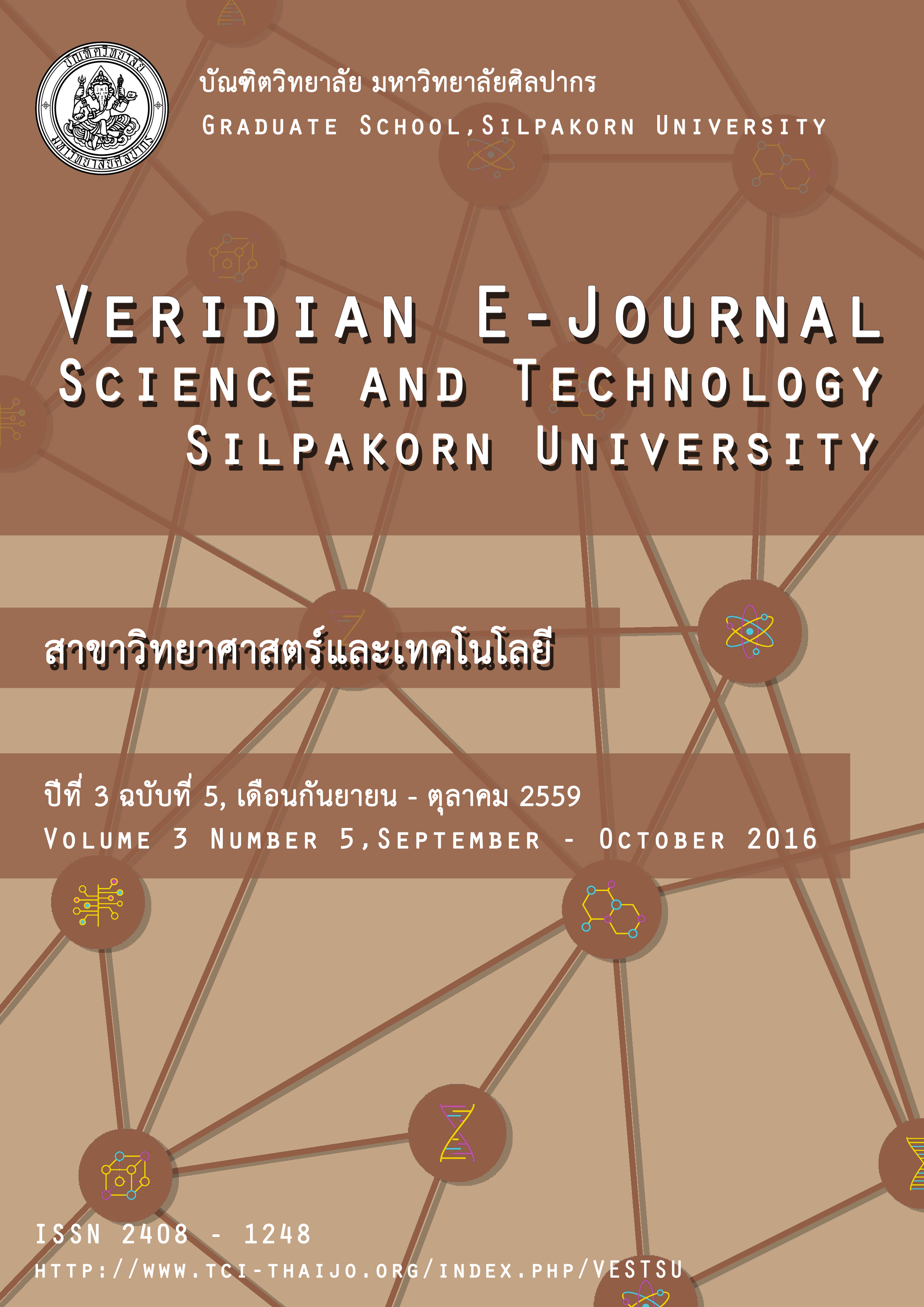การประยุกต์ใช้สีธรรมชาติจากใบมะม่วงในซิลิโคน
Main Article Content
Abstract
จากการที่ผู้บริโภคได้หันมาให้ความสนใจเกี่ยวกับผลกระทบของการใช้สีย้อมสังเคราะห์ที่มีต่อสุขภาพและสิ่งแวดล้อม สีย้อมธรรมชาติจึงเป็นตัวเลือกที่ดีสำหรับการย้อมสิ่งของต่าง ๆ เช่น สิ่งทอ ของเล่นเด็ก เครื่องสำอาง และเครื่องอุปโภค ซึ่งมักจะมีการใช้ซิลิโคนเป็นวัตถุดิบในการผลิต ในงานวิจัยนี้จึงได้สนใจที่จะนำสีธรรมชาติจากใบมะม่วงในรูปของน้ำสีและผงสีมาประยุกต์ใช้ในซิลิโคน จากผลการทดลองพบว่าน้ำสีจากใบมะม่วงจะมีสีน้ำตาลอมเหลืองและผงสีจากใบมะม่วงจะมีสีเหลือง โดยผงสีที่ได้นั้นมีความเป็นอสัณฐานวิทยา (amorphous) และมีองค์ประกอบของคาร์บอน (Carbon, C) ออกซิเจน (Oxygen, O) อลูมินัม (Aluminum, Al) ซัลเฟอร์ (Sulfer, S) เป็นร้อยละ 23, 56, 18 และ 3 โดยน้ำหนัก ตามลำดับ เมื่อศึกษาชิ้นงานซิลิโคนที่ผสมน้ำสีและผงสีจากใบมะม่วงพบว่า น้ำสีและผงสีจากใบมะม่วงสามารถกระจายตัวได้ดีในซิลิโคน โดยน้ำสีจากใบมะม่วงจะทำให้ซิลิโคนมีสีน้ำตาลอมเหลือง ในขณะที่ผงสีจากใบมะม่วงจะให้สีเหลืองแก่ซิลิโคน และความเข้มของสีในซิลิโคนจะเพิ่มขึ้นเมื่อปริมาณน้ำสีและผงสีที่ใส่เพิ่มขึ้น นอกจากนี้จากการศึกษาความคงทนของการติดสีของชิ้นงานพบว่าชิ้นงานซิลิโคนที่ผสมผงสีมีการหลุดของสีน้อยกว่าชิ้นงานซิลิโคนที่ผสมกับน้ำสี ทำให้การซีดจางของสีที่ชิ้นงานช้าลงคงความสดของสีได้นาน
Natural dyes have grown into an interesting choice for dyeing, especially in the fashion industry because of the significantly increase of health awareness and environmental impact of the synthetic dyes from the industrial sector. Silicone is one of the most frequently-used raw materials for manufacturing of daily life goods. In this study, the natural dyes from mango leaf were used for coloring of silicone. The prepared dye and lake pigments from mango leaf were yellow brown and yellow, respectively. The study of lake pigments morphology by SEM and XRD techniques showed that they were amorphous. EDX results showed that lake pigments from mango leaf consisted of carbon, oxygen, aluminum and sulfur with 23%, 56%, 18% and 3% by weight, respectively. Moreover, both dye and lake pigments could mix well with the silicon. The sample of silicon mixed with dye exhibited yellow brown color, while the sample of silicon mixed with lake pigments was yellow. When the added amounts of dye or lake pigments were increased, the colors of the samples turned deeper. In addition, the results from color releasing test showed that there were some leached dyes from the samples, while in case of the lake pigment samples, the leaching was much slower, therefore, the color endurance of the lake pigment samples were better than the dye samples.

